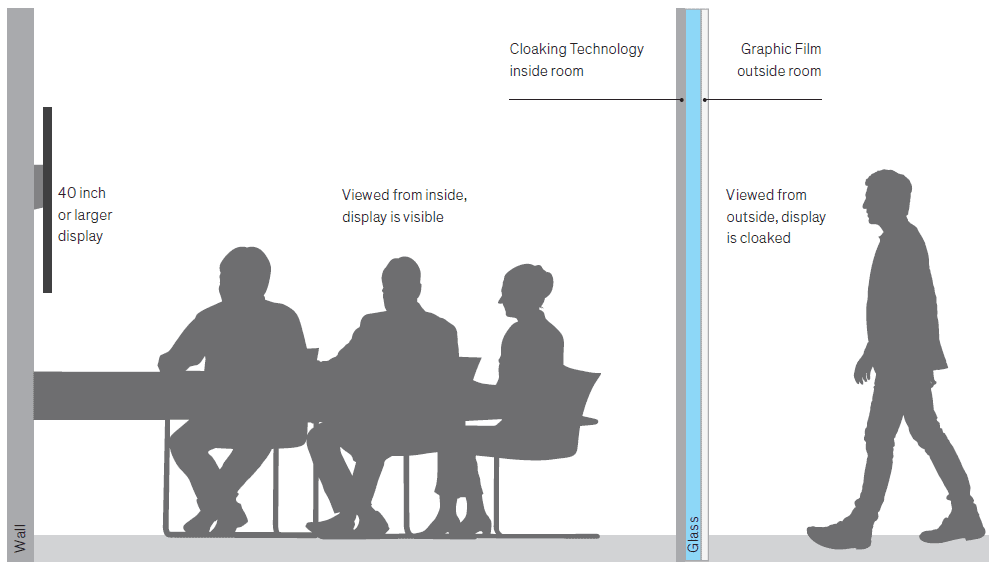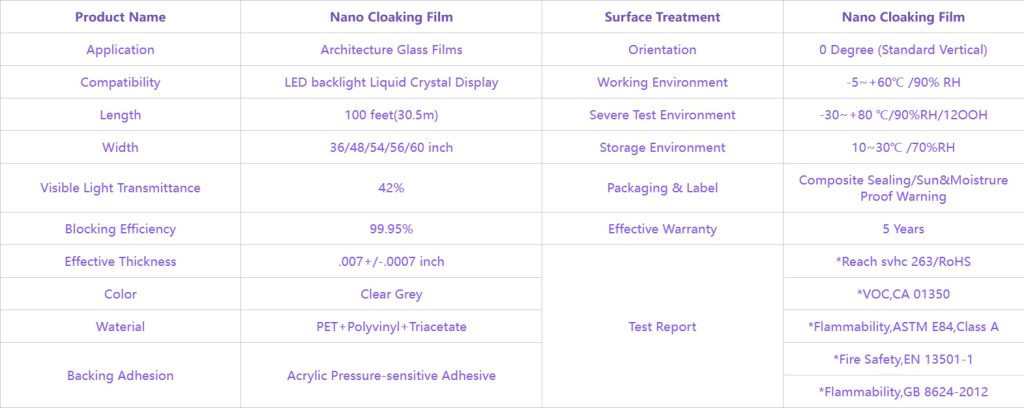Nano cloaking film is an advanced material designed to render objects invisible or less detectable by manipulating light waves. This technology is inspired by the concept of cloaking devices from science fiction and is based on the principles of metamaterials and nanotechnology.
Cloaking Film is a commercial product designed to selectively obscure digital screens from outside view while keeping the rest of the glass surface transparent. This innovative technology is particularly useful in office environments where privacy is needed for displays without isolating the space entirely.
How Nano Cloaking Film Works
When applied to a glass wall or a window, Cloaking Film blacks out screens behind it. The transparent window film blocks light waves transmitted through LED screens. This makes them look like they’re turned off. Everything else in the room looks completely normal. While privacy screens have existed for laptops and individual monitors for quite sometime, Cloaking Film brings it to the architectural scale.
Nanotechnology
The film utilizes nanotechnology to achieve this selective filtering. The microscopic structures within the film are precisely engineered to interact with the light frequencies typical of digital displays, effectively cloaking the screen content.

Technical Datasheet

Benefits of Casper Cloaking Film
Enhanced Privacy
Screen Obscuration: It prevents sensitive information displayed on screens from being visible to unauthorized viewers outside the immediate viewing area.
Confidentiality: Ideal for meeting rooms, offices, and other spaces where confidential information is frequently displayed.
Maintained Aesthetics
Transparency: The film does not obstruct the view through the glass, preserving the open-plan office aesthetic.
Design Integration: It seamlessly integrates with existing glass walls and partitions without the need for bulky curtains or blinds.
Energy Efficiency
Natural Light: Allows natural light to penetrate deeper into the office space, reducing the need for artificial lighting.
Temperature Control: Some variants of the film may also offer UV protection and slight thermal insulation, contributing to better temperature regulation.
Applications of Nano Cloaking Film
Corporate Offices
Conference Rooms: Ensures that presentations, video calls, and sensitive discussions are not visible to passersby.
Executive Offices: Provides privacy for executives while maintaining an open, collaborative environment.
Financial Institutions
Trading Floors: Protects sensitive financial data displayed on monitors from being seen by unauthorized individuals.
Branch Offices: Maintains client privacy during meetings and consultations.
Healthcare Facilities
Patient Consultation Rooms: Ensures privacy for patient information displayed on screens during consultations.
Administrative Areas: Protects sensitive administrative data from being visible to patients and visitors.
Educational Institutions
Classrooms and Labs: Protects proprietary or sensitive academic information displayed during lessons or research.
Administrative Offices: Maintains privacy for staff while allowing transparency for a welcoming environment.
Technical Details of Nano Cloaking Film
- Composition and Structure
Layers: Nano Cloaking Film is made up of multiple layers of materials engineered to interact with specific wavelengths of light. Each layer is designed to filter out the light frequencies emitted by LED and LCD screens.
Nanoparticles: The film incorporates nanoparticles or nanostructures that are precisely arranged to achieve the desired optical effects. These structures can be tuned to block light from screens while allowing other wavelengths to pass through. - Optical Properties
Transparency: The film is designed to maintain high transparency for visible light, ensuring that it does not obscure the overall view through the glass.
Selective Filtering: By targeting the specific wavelengths of light emitted by screens (typically in the blue and green spectrum), the film can make digital displays appear black or opaque from outside the protected area.